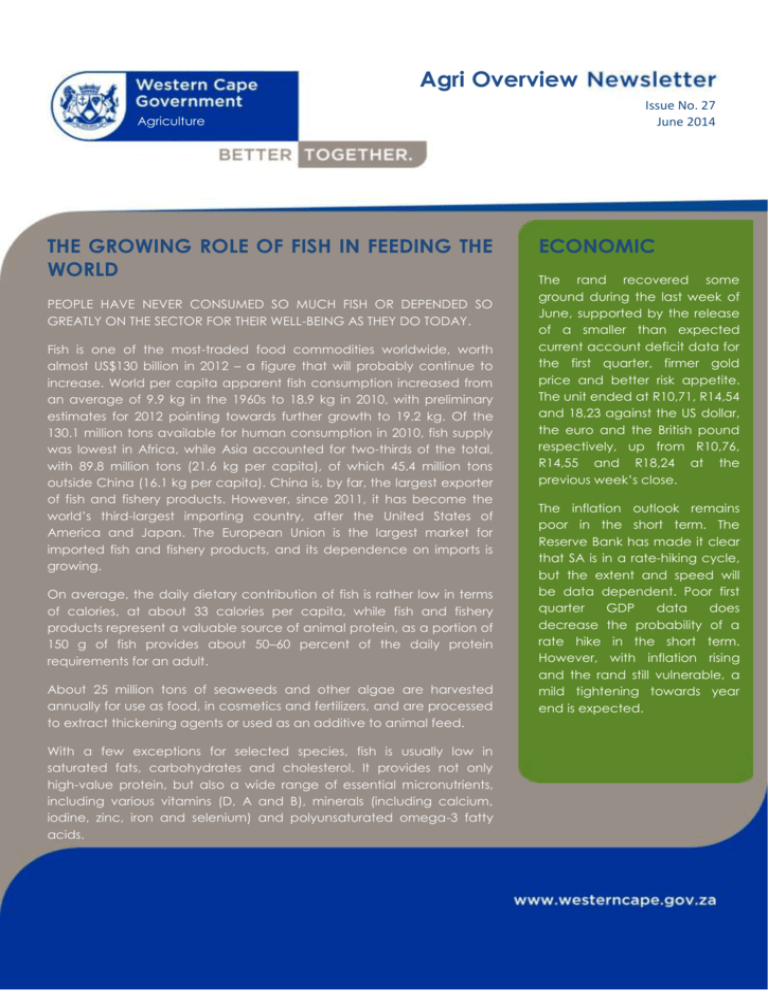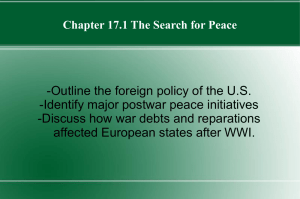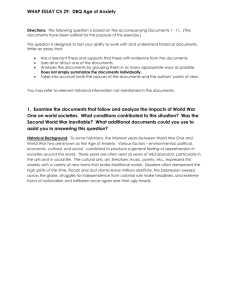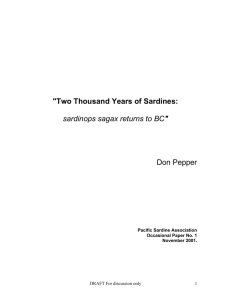June 2014 - Western Cape
advertisement

Agri Overview Agriculture THE GROWING ROLE OF FISH IN FEEDING THE WORLD PEOPLE HAVE NEVER CONSUMED SO MUCH FISH OR DEPENDED SO GREATLY ON THE SECTOR FOR THEIR WELL-BEING AS THEY DO TODAY. Fish is one of the most-traded food commodities worldwide, worth almost US$130 billion in 2012 – a figure that will probably continue to increase. World per capita apparent fish consumption increased from an average of 9.9 kg in the 1960s to 18.9 kg in 2010, with preliminary estimates for 2012 pointing towards further growth to 19.2 kg. Of the 130.1 million tons available for human consumption in 2010, fish supply was lowest in Africa, while Asia accounted for two-thirds of the total, with 89.8 million tons (21.6 kg per capita), of which 45.4 million tons outside China (16.1 kg per capita). China is, by far, the largest exporter of fish and fishery products. However, since 2011, it has become the world’s third-largest importing country, after the United States of America and Japan. The European Union is the largest market for imported fish and fishery products, and its dependence on imports is growing. On average, the daily dietary contribution of fish is rather low in terms of calories, at about 33 calories per capita, while fish and fishery products represent a valuable source of animal protein, as a portion of 150 g of fish provides about 50–60 percent of the daily protein requirements for an adult. About 25 million tons of seaweeds and other algae are harvested annually for use as food, in cosmetics and fertilizers, and are processed to extract thickening agents or used as an additive to animal feed. With a few exceptions for selected species, fish is usually low in saturated fats, carbohydrates and cholesterol. It provides not only high-value protein, but also a wide range of essential micronutrients, including various vitamins (D, A and B), minerals (including calcium, iodine, zinc, iron and selenium) and polyunsaturated omega-3 fatty acids. Issue No. 27 June 2014 ECONOMIC The rand recovered some ground during the last week of June, supported by the release of a smaller than expected current account deficit data for the first quarter, firmer gold price and better risk appetite. The unit ended at R10,71, R14,54 and 18,23 against the US dollar, the euro and the British pound respectively, up from R10,76, R14,55 and R18,24 at the previous week’s close. The inflation outlook remains poor in the short term. The Reserve Bank has made it clear that SA is in a rate-hiking cycle, but the extent and speed will be data dependent. Poor first quarter GDP data does decrease the probability of a rate hike in the short term. However, with inflation rising and the rand still vulnerable, a mild tightening towards year end is expected. SOUTH AFRICAN WINE: HARVEST REPORT 2014 Despite a challenging season characterised by high, and in some instances untimely rainfall, the South African wine industry expects an average sized, good quality wine grape harvest, with exceptional harvests in especially the coastal regions. The total harvest will be approximately 2.6% smaller than the record harvest in 2013 and consumers can look forward to high quality wines from the 2014 harvest year. Ideal dry, moderate conditions reigned during ripening in January and mid-February, after which a warm period accelerated ripening and resulted in great pressure on intakes in some areas. Cooler weather in March enhanced colour formation and flavour retention in later red cultivars. Regular rainfall at the end of March delayed ripening again and extended the harvest to mid-April. CAN HIGH-VALUE GAME IMPROVE YOUR VELD? Generally speaking, the productivity of veld in South Africa is far below its full potential, mainly due to overgrazing. Many farmers feel that overstocking is to blame and seek to reduce livestock numbers. One way of doing this is to replace livestock with high-value game. A farmer in the Karroo recently replaced his merino ewes with impala’s. The trouble is, a few impala’s in a camp will selectively graze and re-graze the better species of grass, thus weakening them. To start with, the undesirable grass species will flourish. What’s required is a large herd of buffalo that can be moved through the camps quickly to graze off the grass. This will stimulate regrowth. Moreover, the buffaloes’ dung, urine and hoof action will stimulate the germination of dormant Compiled by: Jacques Murdoch Telephone: 021 808 5197 Email: jacquesm@elsenburg.com DISCLAIMER Although everything has been done to ensure the accuracy of this information, Western Cape Department of Agriculture therefore accepts no liability that can be incurred resulting from the use of this information. grass seeds and provide fertility for good growth. It is therefore possible to improve the veld, all that’s required is a manageable herd of tame ‘buffaloes’ to provide the very necessary tongue, hoof and fertiliser inputs. WHEAT Comparing the final calculated crop figures with the numbers set by the CEC during February 2014, the size of the commercial wheat crop is now 1,870 mill. tons, which is 65 550 tons or 3,63% more than the final crop estimate figure of 1,804 mill. tons. For malting barley the recalculated crop size is 267 500 tons, which is 1 498 tons or 0,56% higher than the final crop estimate figure of 266 002 tons. The final recalculated canola crop estimate figure is 112 000 tons, which is slightly lower (41 tons or 0,04%) than the final crop estimate figure of 112 041 tons. WOOL Good demand conditions and a significantly weaker currency contributed to higher prices at the final sale of the season and the Cape Wools Merino indicator gained 3,2% on the previous sale to close at R112,91/kg (clean). This is an increase of 10,7% on the opening sale and 2,4% higher than the corresponding sale of the previous season. There was a considerable large offering of 15 596 bales of which a sales percentage of 97% was obtained. WEATHER The province experienced normal climatic conditions for this time of the year. The livestock and veld condition are reasonable. Most of the winter crops have been planted. The level of dams is higher as compared to last year during the same time (83% in 2014 and 71% in 2013). AHS – CONTROL MEASURES RELAXED The last confirmed case of African horse sickness in the Porterville/Wellington and surrounds area was the 6th May 2014 while the last confirmed case in the Robertson area was on 21st May 2014. This, in conjunction with the present time of year that is not normally associated with the successful transmission of African horse sickness, as well as the recent spate of cold weather, snow and heavy frost in the regions affected by the outbreak, the veterinary control measures detailed in the relevant veterinary notices and situation reports has been relaxed. This will be of immediate effect. The normal movement requirements of equines into, within, out of and through the various African horse sickness zones in South Africa, remains as normal. Sources: FAO StatsSA Milk Producers Organisation Grain SA Department of Water Affairs South African Reserve Bank South African Agricultural Machinery Association and RGT SMART CapeWools SA Nedbank Landbou Weekblad









